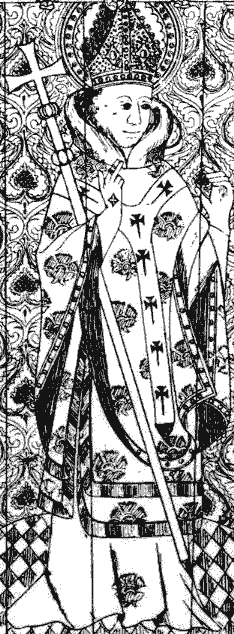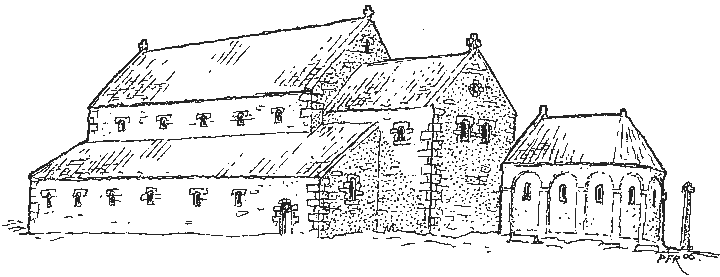Saint Wilfrid
and his Church
 A 15th-century artist painted St Wilfrid for the canons of Hexham Priory. Since no-one knew what the long-dead Wilfrid looked like, he was shown simply as a richly-robed archbishop. The canons thus honoured their church's founder, who for nearly half a century had led the struggle for Christianity in England.
A 15th-century artist painted St Wilfrid for the canons of Hexham Priory. Since no-one knew what the long-dead Wilfrid looked like, he was shown simply as a richly-robed archbishop. The canons thus honoured their church's founder, who for nearly half a century had led the struggle for Christianity in England.
Wilfrid was born just as the new faith arrived in Anglo-Saxon Northumbria; as he grew up, Bishop Aidan and Irish-trained monks from Iona were busily spreading the Word. Wilfrid, a pushful youth, persuaded the Northumbrian queen to send him for schooling to Aidan's Holy Island monastery; but there he found that humble Irish monks and tiny wooden churches did not meet his grander vision.
Seeking an alternative, Wilfrid set off on the long journey to Rome. staying on the way with the Bishop of Lyons to sample the Gaulish church. During six exciting years he saw richly decorated stone churches where he heard glorious music and liturgy; and he met political bishops who shared authority with French sovereigns. At Rome, he often prayed in the monastery church of St Andrew, whose prior Augustine had taken Christianity to Canterbury sixty years earlier.
When at last Wilfrid returned, he was soon in the midst of controversy. Disagreement over customs and calendar between the Celtic [Irish] churchmen and those who followed the Roman pattern were slight but annoying. While Oswiu of Northumbria, the most powerful ruler in Britain, rejoiced for the Celtic Easter festival, his Kentish-bred queen was still fasting for Lent. Oswiu called a synod of church leaders at Whitby, and there Wilfrid's wide experience, his fluency in Latin and Northumbrian English, his faith and confidence, brought him forward as the main spokesman for Rome in opposition to Bishop Colman of Lindisfarne and his team. Oswiu decided to take his people over to the Roman camp; Wilfrid had helped settle the future of English worship.
Now acclaimed and respected, Wilfrid remained for forty-five tireless years a leader in the English Church, as bishop, missionary, abbot, church-builder and adviser to kings. He faced many difficulties, for ambition and arrogance brought him into conflict with two successive Northumbrian kings and two archbishops of Canterbury. He was for a time imprisoned, and spent many years journeying to and from Rome to seek help from the Pope. But on his travels he never paused in his mission, and Christianity flourished thanks to his efforts. As missionary or bishop he guided at various times the Northumbrians, the Mercians, the men of Sussex and Wight, and the people of Frisia. He made Anglo-Saxon rulers acknowledge the vital role of the Church alongside the state. The churches he built were places of beauty and awe, his monasteries centres of devotion, learning and culture. The great houses of St Peter at Ripon and St Andrew at Hexham were buildings the like of which had not been seen in Britain since Roman times. He brought from Italy the Benedictine Rule to order monkish lives, and he collected on his travels treasures and saints' relics, books and ideas to enrich his monasteries.
Queen Etheldreda of Northumbria gave Wilfrid land on which he built the Benedictine monastery dedicated to St Andrew which became Hexham Abbey and Cathedral. Wilfrid's biographer, Stephen, wrote in wonder of
the depth of its foundations in the earth, and its crypts of wonderfully dressed stone, and the manifold building above ground, supported by various columns and many side aisles, and adorned with walls of notable length and height, surrounded by various winding passages with spiral stairs leading up and down; … nor have we heard of any other house on this side of the Alps built on such a scale.
Only the crypt survives, but that shows how St Wilfrid's great church was built from stone quarried by the Romans four or five centuries before. It was also richly adorned: we know that Bishop Acca provided ornaments of gold, silver and precious stones, with hangings of purple and silk. Either Wilfrid or, more likely, his successors, added painted sculptures, relief panels and friezes, and many fragments of these survive built into the present nave walls and niches.
From the traces of its remaining foundations we can form some idea of the size and shape of Wilfrid's church. The latest attempt to work out how it may have looked is Eric Cambridge's suggestion of a long nave, slightly narrower than the present one, flanked by aisles or porticus chapels. The chancel was smaller, with the high altar immediately above the shrine in the crypt and somewhere near the present carpeted steps. East of the main church stood a separate chapel; the foundations of its apse remain below the present quire. This is Peter Ryder's drawing of the buildings, based on the Eric Cambridge plan.

These awe-inspiring stone buildings brought to simple Northumbrians living on the fringe of the known world something of the sophisticated style of Rome and Gaul, and the full splendour of the Christian faith.
Wilfrid's Dates
All these dates are probable but not certain. Wilfrid may have been born in 634, and died perhaps in 710, while Hexham Abbey was founded at some time during the years 670–674. All our knowledge of Wilfrid comes from two of his contemporaries: Stephen [sometimes confused with Eddlus] who wrote an admiring biography, and Bede. Both are partisan, and leave many gaps in the story.
| A.D. 634 |
Birth of Wilfrid into a noble Northiumbrian family; Cuthbert born in the same year. |
| 648 |
Wilfrid enters the monastery of Lindisfarne. |
| 653 |
He leaves Lindisfarne for Kent |
| 653–654 |
Wilfrid reaches Lyons with Benedict Biscop, and remains there for a year before proceeding to Rome where he spends many months in devotion at the shrines of saints. |
| 655–658 |
Wilfrid returns to Lyons for three years and returns to England after Bishop Aunemundus is executed |
| 661 |
He is made abbot of Ripon. |
| 663 |
Wilfrid is ordained priest by Bishop Agilbert. |
| 664–666 |
Synod of Whitby; Wilfrid speaks for Roman practice, King Oswiu agrees, and the Celtic bishop and monks submit or return to Ireland. Wilfrid becomes Bishop of the Northumbrians with his seat at York, but goes to Gaul for consecration at Compiègne. He is shipwrecked on the Sussex coast on his return journey and attacked by the South Saxons. He returns to Northumbria to find himself deposed, and replaced as bishop of York by Chad. |
| 666–669 |
He acquires land and founds monasteries in Mercia. He works to institute Roman customs, introduces the Rule of St Benedict, and
brings the singing-master Eddius Stephanus to the north from Kent. |
| 669 |
Wilfrid is restored to his see of York by Archbishop Theodore. |
| 672–673 |
Given lands by Queen Æthelthryth [Etheldreda], Wilfrid sets about building the Benedictine Abbey of Hexham. |
| 673 |
Birth of Bede. |
| 678–680 |
Wilfrid quarrels with King Aldfrith and Archbishop Theodore, who partitions his diocese. Wilfrid visits the Pope and collects saints' relics from Rome, on the way converting pagans in Frisia and Sussex. Returning, he still meets hostility, and is briefly imprisoned. |
| 681 |
Wilfrid takes refuge with Berhtwald, nephew of King Æthelræd and is given a small monastery. Driven out by Ecgfith's enmity, he flees to Wessex and then to Sussex where King Æthelwealh supports his creation of an episcopal see at Selsey |
| 684 |
Cuthbert is elected bishop, initially of Hexham, but because he wishes to be bishop of Lindisfarne, Bishop Eata is transferred back to Hexham; [Tunberht, the incumbent bishop of Hexham had been deposed]. |
| 685 |
Accession of Aldfrith following death of Ecgfrith at he battle of Nechtanesmere; Bishop Eata of Hexham dies and is succeeded by John of Beverley. |
| 686 |
Reconciled with the new King Aldfrith, Wilfrid is restored to Hexham, then the see of York, and the monastery at Ripon. |
| 691 |
Another quarrel and exile. Wilfrid works in Mercia, East Anglia, Wessex and Kent, advising kings and building churches. |
| 695 |
Translation of St Æthelthryth [Etheldreda] at Ely, possibly in the presence of Wilfrid, who attested to the incorruption of her body. |
| 702 |
The Council of Austerfield is called by Archbishop Berhtwald to decide the case of Wilfrid's rights. He is officially dispossessed and
again appeals to Rome. |
| 703 |
He makes his third journey to Rome, travelling first to Utrecht to visit the Frisian mission. He is again vindicated by the Pope. |
| 704–705 |
While returning through Gaul Wilfrid falls ill, and is told in a vision to build a church in honour of Our Lady.
Wilfrid returns to Northumbria and may then have built the church of St Mary in Hexham. Aldfrith dies. |
| 706 |
Wilfrid's monasteries are at last restored to him, and he is Bishop of Hexham until 709. |
| 710 |
Death of Wilfrid at Oundle in his 76th year, after 46 years as bishop; he is buried at Ripon. |
 A 15th-century artist painted St Wilfrid for the canons of Hexham Priory. Since no-one knew what the long-dead Wilfrid looked like, he was shown simply as a richly-robed archbishop. The canons thus honoured their church's founder, who for nearly half a century had led the struggle for Christianity in England.
A 15th-century artist painted St Wilfrid for the canons of Hexham Priory. Since no-one knew what the long-dead Wilfrid looked like, he was shown simply as a richly-robed archbishop. The canons thus honoured their church's founder, who for nearly half a century had led the struggle for Christianity in England.
